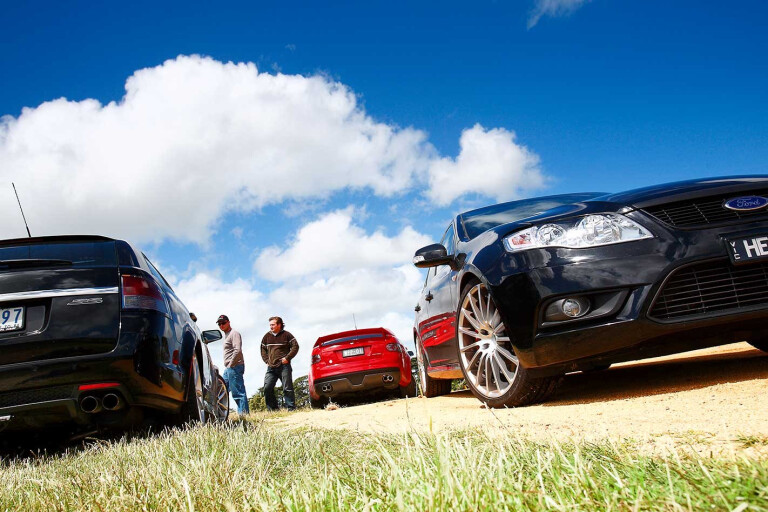
Overkill is everywhere. A hollow-point bullet is designed to not just shoot stuff, but to explode once it has pierced whatever it hits. Clearly, simply shooting a hole in something is not enough for some people.
This feature was first published in MOTOR magazine's February 2009 issue.
In the case of my grandmother, strawberries just weren’t sweet enough – she used to sprinkle sugar over them. She was almost blind from diabetes, but she could find that sugar-bowl by feel. But overkill is not always a bad thing.
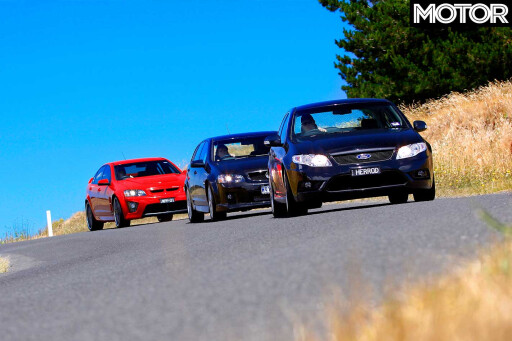 Which is lucky, because when it comes to what’s happening in the world of big Aussie cars with big-mutha engines, the concept of too much being barely enough is alive and well.
Which is lucky, because when it comes to what’s happening in the world of big Aussie cars with big-mutha engines, the concept of too much being barely enough is alive and well.
Forget that a Commodore with a 6.0- or 6.2-litre V8 is more than even the most fervent tappet-head was dreaming about even a decade ago. And forget that a home-brewed Falcon six with a V8-bashing factory intercooled turbo was equally the stuff of fantasy. Forget it all, because the game has really moved on.
See, there will always be a core group of people who reckon the stock stuff is a bit on the wimpy side. And it’s not that the factories don’t cater for them, because that’s the whole point; people like that don’t want what everybody else can buy off the shelf. They want more. They want something special. And they want it now.
Of course, as the off-the-peg gear gets better and faster, so too does the aftermarket up the ante in response, continuing to give the world’s headbangers what they crave. Or more.
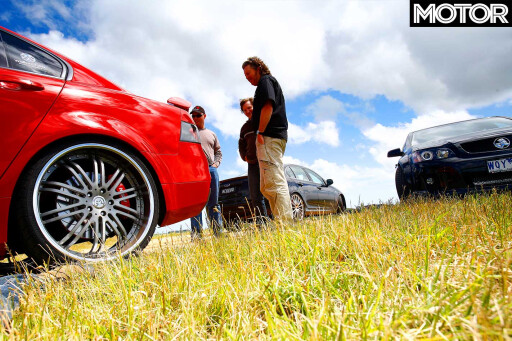 And when even a base-model Commodore V8 is packing 270kW, that’s one hell of an ante to be messing with. Long gone are the days when dropping a Chev small-block into your HZ Kingswood was enough.
And when even a base-model Commodore V8 is packing 270kW, that’s one hell of an ante to be messing with. Long gone are the days when dropping a Chev small-block into your HZ Kingswood was enough.
But more than that, the aftermarket modifiers haven’t just had to get more creative, they’ve had to get a whole lot smarter. Computer control of everything from the injection to the glovebox lid has meant that modifiers have had to get savvy and get there quickly. And when you sample the latest offerings from the mainstream modifiers (now there’s an oxymoron) you can see that overkill has never been more tempting.
Let’s start with the Walkinshaw Performance treatment, as applied to an HSV Clubsport. Right from the moment you sidle up to it, it’s a bit of an eyeball wrencher.
 Okay, if it was my money, WP would be keeping the body add-ons, including that bonnet scoop that occupies more real estate than the average townhouse.
Okay, if it was my money, WP would be keeping the body add-ons, including that bonnet scoop that occupies more real estate than the average townhouse.
Same goes for the 22-inch alloys, which are really the only way to make such big brakes look lost and lonely inside the rim. More than that, the painted-on 245/30 front and (squeeze me?) 285/25 rear tyres eradicate any ride quality once you’re moving beyond urban speeds, or the bumps get bigger than pimples.
I’m also left wondering whether anybody at WP has actually driven this car any distance, because pretty much any bump is enough to send the front tyres and wheelarches into serious interface. Even in a dead straight line, the fronts smack into the arches with wince-inducing results and, frankly, you couldn’t live with it like that.
 But you wouldn’t change a thing about the brakes. Front rotors are 365mm and the rears are 350, with six-piston AP Racing grabbers up front and four-potters out back. The pedal feel is great and there’s so much stopping power; a revelation after standard Holden tackle.
But you wouldn’t change a thing about the brakes. Front rotors are 365mm and the rears are 350, with six-piston AP Racing grabbers up front and four-potters out back. The pedal feel is great and there’s so much stopping power; a revelation after standard Holden tackle.
Keeping it all out of the dirt is WP’s suspension package with shorter springs and a shorter shock body, as well as revised bump-stops. But, again, those monster wheels compromise the end result; they’re so damn tall that the Clubby looks like a rollerskate on steroids.
But you and I both know that it’s what’s under the lid that counts here. And in that regard, the Walky has got things absolutely covered off.
The 6.2 retains the stock 10.7:1 compression ratio, which is a bit of a surprise when you see what’s been bolted to the top of it. The twin-screw blower is painted to match the rest of the car and sits there like a squat little red Buddha, calling the shots to the tune of 470kW by the time 6500rpm has turned up.
 But what those numbers don’t tell you is that there’s incredible stomp available right from idle, which is exactly what this type of blower and big-inch V8 combination is renowned for delivering.
But what those numbers don’t tell you is that there’s incredible stomp available right from idle, which is exactly what this type of blower and big-inch V8 combination is renowned for delivering.
With the six-speed manual (and a tougher LS7-spec clutch), there’s an insane level of squirt on tap along with a distinctive – and loud – blower whine that won’t please everyone, but which we reckon sounds the biz.
The other VE-based gadget featured here started out as a Commodore SS-V Series Sportwagon with a manual box and the optional 20-inch rims. And while it’s the least modified of this lot, its mods are the important ones. There’s a set of lowered springs, but it’s the supercharger installation by Corsa Special Vehicles that defines this very quick family truckster.
 CSV boss man Peter Dichiera is wary about handing over cars to customers that are too explosive right off idle. His theory is that a car that develops its grunt further up the rev range not only feels like it’s building to something, it also makes it safer to drive in the wet and far less likely to scare the lady of the house into never driving it again.
CSV boss man Peter Dichiera is wary about handing over cars to customers that are too explosive right off idle. His theory is that a car that develops its grunt further up the rev range not only feels like it’s building to something, it also makes it safer to drive in the wet and far less likely to scare the lady of the house into never driving it again.
So, the centrifugal blower makes sense because the 6.0-litre feels absolutely like a stocker as you slip out the standard clutch and haul into the traffic flow. But bury the boot and by 5000rpm, the SS V’s force-fed bent eight is attempting to paste 300kW – call it around 400kW at the crank – straight to the deck.
There’s a nice ramp-up in urge as the blower gets into its stride and the engine feels like its welling up to something really special. Which it is. And let’s not forget that the basic engine (and CSV doesn’t so much as lift a cylinder head) is a pretty handy thing from the get-go anyway, so a lack of grunt is never the reality.
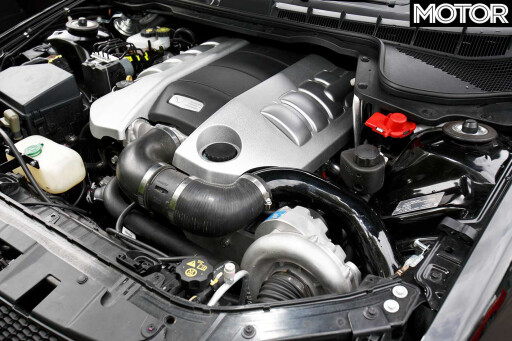 Over and above the pump itself, the CSV kit adds an intercooler and a specific exhaust – in this case, quite a fruity one at the behest of the vehicle’s owner – but Dichiera is adamant that neither bigger injectors nor an up-rated fuel pump system is necessary at this level. The owner reckons the stock tyres and brakes are also up to the job, so that’s what it runs. And we have to admit that having such potential dressed nicely incognito has a helluva lot of stealthy street appeal. A cop magnet it ain’t.
Over and above the pump itself, the CSV kit adds an intercooler and a specific exhaust – in this case, quite a fruity one at the behest of the vehicle’s owner – but Dichiera is adamant that neither bigger injectors nor an up-rated fuel pump system is necessary at this level. The owner reckons the stock tyres and brakes are also up to the job, so that’s what it runs. And we have to admit that having such potential dressed nicely incognito has a helluva lot of stealthy street appeal. A cop magnet it ain’t.
The third hell-raiser here is the work of Melbourne-based tuner Rob Herrod, who has been spinning spanners on blue-oval gear for more years than he cares to remember.
Like CSV’s Sportwagon, stealth is the theme here. And the blacked-out brightwork, including the side indicators, gives the G6E Turbo a smooth, classy (if slightly sinister) look that won’t have the rozzers doing head-spins.
 It’s also copped some interior goodies. The front seats are re-bolstered for better support and there’s a Herrod-specific dashboard on order that hadn’t arrived when we snavelled the car. Fair enough, but it’s the oily, noisy bits we wanted to try.
It’s also copped some interior goodies. The front seats are re-bolstered for better support and there’s a Herrod-specific dashboard on order that hadn’t arrived when we snavelled the car. Fair enough, but it’s the oily, noisy bits we wanted to try.
For a start, the brakes are truly mighty. They’re essentially PBR’s M-Series performance brakes: six-pot fronts and four-pot rears, with huge two-piece rotors. And as a straight-from-the-catalogue set-up, they take some beating.
Round bits are 20-inch German-sourced rims, 8.5-inches wide and loaded with 245/35 Dunlop Sport Maxx tyres. The rubber is not as aggressive as some – the Walky, for instance – but it’s also not as unforgiving, either. A new spring package drops it all down a bit but, in terms of ride quality, it keeps the end result quite civilised.
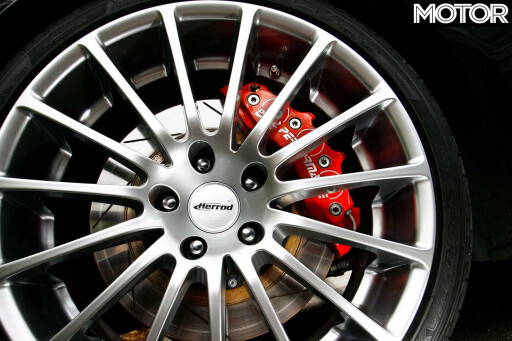 The upgrade from the stock G6E Turbo’s 270kW comes from Herrod’s own stainless engine-pipe and cat-back exhaust combined with a bigger intercooler, a K&N air-filter and an in-house tune.
The upgrade from the stock G6E Turbo’s 270kW comes from Herrod’s own stainless engine-pipe and cat-back exhaust combined with a bigger intercooler, a K&N air-filter and an in-house tune.
“(This kit) has a fairly easy 400kW in it,” says Herrod. And you can thank a touch over 1.0bar of boost (up from the standard car’s 0.6bar) for the bulk of that. But there are no secret herbs and spices here; what’s working for it is the inherent tunability in modern turbo motors and careful matching of the various components. Herrod may have made his name dealing with V8 Henrys but, if this car is anything to go by, he stands to become the go-to guy for boosted sixes, too.
Given that you can turn up at any of these tuning shops and pick the eyes out of the various bits and pieces on offer, there are no ‘standard’ WP, CSV or Herrod vehicles.
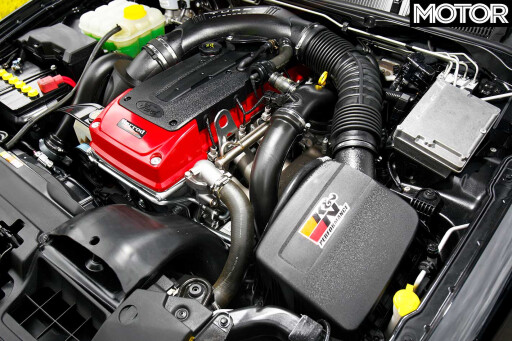 Some folks will want the big brakes, others won’t. Some will be content with a set of lower springs, others will want fully adjustable dampers and R-spec hoops. But the common denominator for owners stumping up the readies will, of course, be the honourable and noble pursuit of chasing extra grunt.
Some folks will want the big brakes, others won’t. Some will be content with a set of lower springs, others will want fully adjustable dampers and R-spec hoops. But the common denominator for owners stumping up the readies will, of course, be the honourable and noble pursuit of chasing extra grunt.
So there’s really only one thing to do: find a deserted runway and have a Driftbox shootout at 10 paces.
The big surprise was that the CSV Sportwagon was the quickest. And since it’s probably a full 70kW down on the Walky, the result raised more than a few eyebrows.
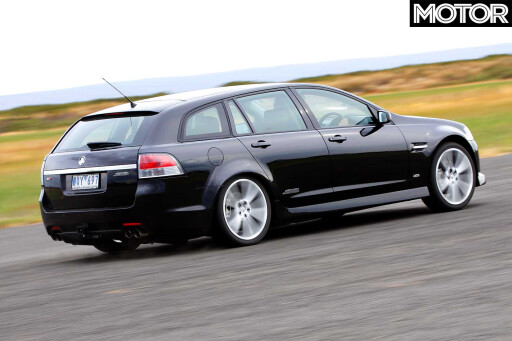 But look closely at the figures, and you can probably see what’s going on. The CSV was one-tenth quicker than the Clubsport to 100km/h (5.0 versus 5.1) and another tenth quicker across the standing quarter (13.1 against 13.2). But the WP car was actually travelling faster at the end of the 400m (182.9km/h versus 181.8), which suggests that the Clubby was going to drag out a lead from
But look closely at the figures, and you can probably see what’s going on. The CSV was one-tenth quicker than the Clubsport to 100km/h (5.0 versus 5.1) and another tenth quicker across the standing quarter (13.1 against 13.2). But the WP car was actually travelling faster at the end of the 400m (182.9km/h versus 181.8), which suggests that the Clubby was going to drag out a lead from
there to the far horizon.
The 80 to 120km/h times paint a clearer pic. Even in sixth gear (where there’s no wheelspin), the WP car (9.9sec) is more than four seconds faster than the CSV (14.1sec). Its low- to mid-rpm poke is simply stunning.
So what’s going on? It’s simple really. The CSV gets its power down better because there’s less of it to contend with as you release the clutch from standstill. And, thus, it just gets out of the hole a whole lot more effectively on meagre street tyres.
 If you revved the Sportwagon to 3000rpm and dropped the clutch, it’d be making about the same power as the WP Clubby does at idle. And it’d go up in tyre smoke too, just like the Walky did most times. But if you take the CSV to about 1500rpm, go carefully with the clutch and then feed the power in, it gets going very smartly indeed.
If you revved the Sportwagon to 3000rpm and dropped the clutch, it’d be making about the same power as the WP Clubby does at idle. And it’d go up in tyre smoke too, just like the Walky did most times. But if you take the CSV to about 1500rpm, go carefully with the clutch and then feed the power in, it gets going very smartly indeed.
It’s worth noting that the CSV was also more consistent than the other two on the less-than-perfect surface, reeling off low-13s time and again.The Walky, meanwhile, only scored the one low-13 from a fluky launch, after a series of mid-13 runs where it just flat-out refused to hook up.
The Herrod car is not quite as flaky off idle as the Walkinshaw-modded car, but it does build boost quickly, which comes in with enough of a bang to light up the rears early on in first gear and right to the hotmix-lifting end of second. If anything, it’s even worse than the Clubby once it’s really into its stride.
 The combination of seamless Newton-metre surge and the slick shifting from the six-speed auto means that the rears have absolutely no time to recover and sniff out grip. It’s a situation made worse by that late-model Falcon’s throttle-by-wire thing that doesn’t really allow throttle-body modulation to any meaningful degree. Roll out and the boost dives. Stay up it and the tyres keep on spinning up.
The combination of seamless Newton-metre surge and the slick shifting from the six-speed auto means that the rears have absolutely no time to recover and sniff out grip. It’s a situation made worse by that late-model Falcon’s throttle-by-wire thing that doesn’t really allow throttle-body modulation to any meaningful degree. Roll out and the boost dives. Stay up it and the tyres keep on spinning up.
Our 0-400m best in the G6E was a 13.6 at 174km/h, with a 0-100m time of 5.4 seconds. Still quick, mind you, but well off what an engine and transmission of this calibre are capable of.
In its simplest form, the CSV Sportwagon is travelling faster than the other two when the real surge arrives. It finds more traction and gets on with it while the other pair are turning their rear rubber into very expensive atoms.
As far as the rest of each package goes, the Herrod-modded Ford is the pick of the crop in terms of living with the thing day-to-day. Jump straight into it from either VE and the Ford’s sharper steering and lighter feel is immediately obvious. And while the big-bore exhaust is a bit noisier, it’s never drummy or annoyingly in-your-face.
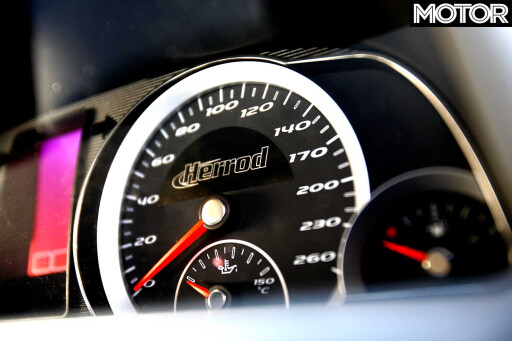 The only let-down is the driving position, which still places you too high, while the steering column’s highest setting isn’t high enough.
The only let-down is the driving position, which still places you too high, while the steering column’s highest setting isn’t high enough.
But the VE stuff isn’t perfect either. You still get the feeling, as you roll around in those big chairs and grapple with the huge tiller, that this was a car made for man-bears. And I’m no tiddler.
In the case of the Walky, the big issues are the wheel-to-arch clearance (or lack of it), the jarring ride and the sheer lairiness of its look. And while the CSV’s uncomplicated nature is nice – as is the big, deep exhaust note – it’s a bit on the feeble side when it comes to brakes.
But all those things can be amended, or eliminated completely, by a simple fiddle with the spec sheet. Our choice would be the stealth approach, but with the mega anchors, full-house engine mods and a set of lightweight 20s with sticky rubber. And if that sounds like a winner, then judging by this lot, you've never been so spoiled for choice.
 What's it cost?
What's it cost?
The Walkinshaw Performance Clubsport tops the ladder here, partly because it’s the most comprehensive makeover, but also because the Clubby is the dearest donor car to start with.
So when you add the $36,360 worth of WP mods to the basic car’s $64,990, you wind up with $101,350. However, we’d ditch a lot of it and just go for the blower ($15,500), the exhaust ($2050), suspension ($690), oil cooler ($1250) and the heavy-duty LS7 clutch ($1500). Which would leave you with a $85,980 proposition. And a very wide smile.
 The Herrod jigger is next and the big-ticket item is the engine pipe work and exhaust at $3500. The intercooler adds $1200 and the ECU tuning a further $1400, both money well spent. The K&N air filter is a piffling $95, while the interior retrim is $1850 (though we could easily live without the latter). The PBR brake package makes sense at $7250, the 20-inch wheels and tyres less so at $7800.
The Herrod jigger is next and the big-ticket item is the engine pipe work and exhaust at $3500. The intercooler adds $1200 and the ECU tuning a further $1400, both money well spent. The K&N air filter is a piffling $95, while the interior retrim is $1850 (though we could easily live without the latter). The PBR brake package makes sense at $7250, the 20-inch wheels and tyres less so at $7800.
All up you’re looking at $78,965, but you easily can see where your dough has gone.
The bargain is CSV’s Sportwagon, which adds just the blower kit and intercooler at $12,000, and $700 worth of springs. Call it $64,990. But it could use a brake upgrade.
FAST FACTS
| 2009 Herrod G6E Turbo | 2009 CSV Sportswagon | 2009 Walkinshaw Clubsport | |
| BODY | 4-door, 5-seat sedan | 5-door, 5-seat wagon | 4-door, 5-seat sedan |
| DRIVE | rear-wheel | rear-wheel | rear-wheel |
| ENGINE | 3984cc in-line 6, DOHC, 24v, turbo | 5967cc 90-degree V8, OHV, 16v, S/C | 6162cc 90-degree V8, OHV, 16v, S/C |
| BORE/STROKE | 92.3 x 99.3mm | 101.6 x 92.0mm | 103.25 x 92.0mm |
| COMPRESSION | 8.8:1 | 10.4:1 | 10.7:1 |
| POWER | 400kW @ 5300rpm | 400kW @ 6000rpm | 470kW @ 6500rpm |
| TORQUE | 780Nm @ 2500rpm | 680Nm @ 4800rpm | 770Nm @ 4500rpm |
| WEIGHT | 1770kg (as standard) | 1890kg (as standard) | 1842kg (as standard) |
| POWER/WEIGHT | 226kW/tonne | 212kW/tonne | 255kW/tonne |
| TRANSMISSION | 6-speed automatic | 6-speed manual | 6-speed manual |
| GEAR RATIOS | 2.98/1.78/1.30/1.00/0.71/0.55 | 3.01/2.07/1.43/1.00/0.84/0.57 | 3.01/2.07/1.43/1.00/0.84/0.57 |
| FINAL DRIVE | 3.73 | 3.45 | 3.70 |
| SUSPENSION (f) | Double A-arms, coil springs, anti roll bar | Struts, A-arms, anti-roll bar | Struts, A-arms, anti-roll bar |
| SUSPENSION (r) | Multi-links, coil springs, anti-roll bar | Multi-links, coil springs, anti-roll bar | Multi-links, coil springs, anti-roll bar |
| L/W/H | 4967/1868/1433mm | 4897/1899/1476mm | 4943/1899/1468mm |
| WHEELBASE | 2838mm | 2915mm | 2915mm |
| TRACKS | 1583/1598mm (f/r) | 1602/1618mm (f/r) | 1592/1590mm (f/r) |
| STEERING | power rack-and-pinion | power rack-and-pinion | power rack-and-pinion |
| BRAKES (f) | 355mm ventilated discs, six-piston calipers | 321mm ventilated discs, two-piston calipers | 365mm ventilated discs, four-piston calipers |
| BRAKES (r) | 355mm ventilated discs, four-piston calipers | 350mm ventilated discs, single-piston calipers | 350mm ventilated discs, four-piston calipers |
| DRIVER AID | ABS, EBD, BA, DSC | ABS, EBD, BA, ESP | ABS, EBD, ESP, TC |
| TYRE SIZES | 245/35ZR20 (f/r) | 245/35R20 (f/r) | 245/30R22 (f), 285/25R22 (r) |
| TYRE | Dunlop SP Sport Maxx | Bridgestone Potenza RE050A | Falken ZR22 |
| FUEL/TANK | 98 octane/68 litres | 98 octane/73 litres | 98 octane/73 litres |
| PRICE (in 2009) | $78,965 (as tested) | $64,990 (as tested) | $101,350 (as tested) |
| PROS | Huge FPV-beating output, excellent brakes, sharp looks | Incredible bang for the bucks, near-stock low-end driveability | Absolutely manic outputs, ferocious rolling punch |
| CONS | Painful to launch, twitchy throttle, should be quicker | Both the seats and the brakes aren’t up to its potential | 22s compromise ride and grip, noisy blower, poor traction |
| RATING | 9 out of 10 stars | 8 out of 10 stars | 8 out of 10 stars |
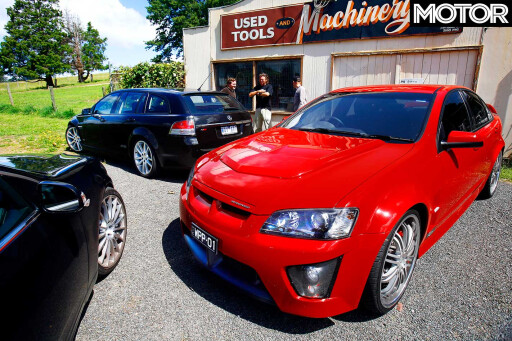 THE NUMBERS
THE NUMBERS
| Herrod G6E Turbo | CSV Sportswagon | Walkinshaw Clubsport | |
| 0-10km/h (sec) | 0.5 | 0.5 | 0.4 |
| 0-20km/h (sec) | 1.0 | 1.0 | 0.9 |
| 0-30km/h (sec) | 1.6 | 1.4 | 1.4 |
| 0-40km/h (sec) | 2.1 | 1.9 | 1.9 |
| 0-50km/h (sec) | 2.5 | 2.4 | 2.4 |
| 0-60km/h (sec) | 3.0 | 2.8 | 2.8 |
| 0-70km/h (sec) | 3.6 | 3.2 | 3.3 |
| 0-80km/h (sec) | 4.1 | 3.9 | 4.1 |
| 0-90km/h (sec) | 4.7 | 4.4 | 4.6 |
| 0-100km/h (sec) | 5.4 | 5.0 | 5.1 |
| 0-110km/h (sec) | 6.2 | 6.1 | 6.2 |
| 0-120km/h (sec) | 7.0 | 6.7 | 6.9 |
| 0-130km/h (sec) | 7.9 | 7.5 | 7.7 |
| 0-140km/h (sec) | 9.0 | 8.3 | 8.5 |
| 0-150km/h (sec) | 10.2 | 9.2 | 9.3 |
| 0-160km/h (sec) | 11.5 | 10.1 | 10.5 |
| 0-170km/h (sec) | 12.9 | 11.6 | 11.6 |
| 0-180km/h (sec) | 14.6 | 12.9 | 12.9 |
| 0-400m | 13.6 @ 174.0km/h | 13.1 @ 181.8km/h | 13.2 @ 182.9km/h |
| 80-120km/h (Drive) | 2.8sec | N/A | N/A |
| 80-120km/h (3rd) | N/A | 3.3sec | 2.8sec |
| 80-120km/h (4th) | N/A | 5.4sec | 4.0sec |
| 80-120km/h (5th) | N/A | 7.1sec | 5.3sec |
| 80-120km/h (6th) | N/A | 14.1sec | 9.9sec |

COMMENTS